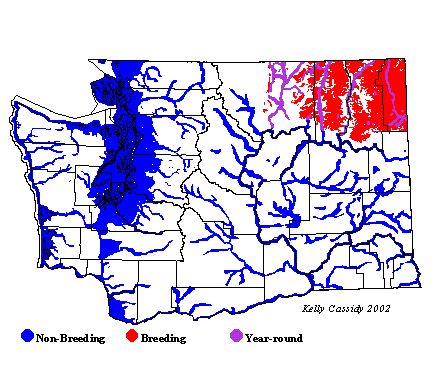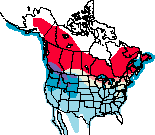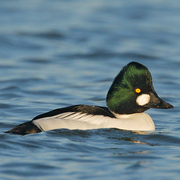Common Goldeneye
General Description
Often found in large rafts outside the breeding season, Common Goldeneyes are frequent winter residents in Puget Sound and on large Washington rivers. The male Common Goldeneye has a dark iridescent-green head that looks black when not in the sun. He also has a prominent round or oval white spot on each side of his face at the base of his black bill. His belly and flanks are white, and his rump is black. His back is mostly white with black bars. The female Common Goldeneye has a gray body, brown head, and yellow eyes. This bird can be very difficult to distinguish from a female Barrow's Goldeneye. The bill of the Common Goldeneye is mostly black with a yellow tip, while that of the Barrow's is mostly yellow. Juveniles are gray with brownish heads, similar to females but with less differentiation between the head and body colors. Consult a field guide or an experienced observer, consider range and habitat, and study nearby males for clues about which female and juvenile goldeneyes might be present.
Habitat
Common Goldeneyes breed worldwide in northern boreal forests. They prefer clear water in small lakes and ponds that are not overwhelmed with submergent and emergent vegetation and which do not support populations of fish. Goldeneyes are cavity-nesting ducks and generally require forested habitat with mature trees (deciduous or coniferous) that offer suitable nesting cavities. During migration, goldeneyes stop on large lakes and rivers to feed while they move between breeding and wintering habitats. They winter primarily in marine areas, in shallow protected bays, estuaries, and large lakes with a sandy, gravel, or rocky substrate. They are occasionally found on sewage lagoons, and non-breeding birds sometimes summer in these areas.
Behavior
Common Goldeneyes are diving ducks and forage mostly under water. Often a whole group of goldeneyes will dive at the same time. Goldeneyes are aggressive and territorial, and the male performs spectacular and complex courtship displays. The female commonly lays eggs in the nests of other Common Goldeneyes and other ducks, especially other cavity-nesting ducks.
Diet
On the breeding grounds, aquatic insects make up the bulk of the diet, and in fact, goldeneyes prefer ponds that lack insect-eating fish which compete for prey. On wintering grounds, mollusks, crustaceans, and fish are the main foods.
Nesting
Female Common Goldeneyes do not usually start breeding until the age of two years, but yearlings may prospect for future nest sites. Females typically return to the areas where they hatched (philopatry), and once they breed, often return to the same nesting site year after year. Pairs form in late winter or early spring. Nests are located in cavities in large trees, 5 to 60 feet above the ground. Cavities are often old Pileated Woodpecker holes, natural cavities made from torn branches, or artificial nest boxes. The nest itself is a depression in existing material (wood chips, leaves, or material from a previous nest) lined with down. The female typically lays 7 to 10 eggs and incubates them for 28 to 32 days. After one or two weeks of incubation, the pair bond dissolves, and the male begins his molt migration. It is not known whether these pair bonds re-form in the fall, but other sea ducks, including Barrow's Goldeneyes, do re-pair, so it is quite possible that Common Goldeneyes do as well. The young leave the nest one to two days after hatching, and the female leads them to areas with abundant food where they feed themselves. Broods will sometimes join other broods in a large crèche. This most often occurs if the female has abandoned a brood early, or if broods are mixed up during territorial disputes between females. Females abandon the young before they can fly, usually at 5 to 6 weeks of age, but occasionally earlier. The young fledge at 8 to 9 weeks of age.
Migration Status
After incubation begins, the males undergo a molt migration, which is usually a short distance and often in a northerly direction to larger lakes, bays, and rivers. Then, late in the fall, they migrate medium distances from these staging areas to the wintering grounds, often not arriving until late October or early November. Males winter farther north than females, often as far north as there is open water. Goldeneyes leave for the breeding areas in late February.
Conservation Status
Common Goldeneyes are more numerous and widespread than Barrow's Goldeneyes. The population appears stable, and numbers have increased in some areas where nest boxes have been provided. Common Goldeneyes have recently begun to take advantage of northern areas with industrial effluent discharge, which keeps the water free of ice in areas that are typically frozen in the winter. The concentration of birds at these sites is of concern since contamination from the effluent is highly possible. Another characteristic of Common Goldeneyes is their tendency to prefer acidified water. Many acid-tolerant insects provide plentiful prey, and most fish cannot live in these highly acid environments, thus reducing competition. Common Goldeneyes' use of these disturbed environments is of concern because of the possible short- and long-term effects of toxins that may also be found in these areas. The cavity-nesting nature of this species makes it vulnerable to logging and other habitat destruction that eliminate natural cavities. Their productivity is relatively low for waterfowl, and their strong fidelity to natal sites makes them slow to colonize new areas, resulting in a population that may be slow to rebound from decreases.
When and Where to Find in Washington
Common Goldeneyes are among the least common breeding ducks in Washington, found nesting only in the northeastern portion of the state, with most birds nesting in north-central and northeastern Canada. From November to April, however, Common Goldeneyes are fairly common on both fresh water and calm salt water in both the eastern and western lowlands. It is one of the most common wintering diving ducks throughout much of Puget Sound, and can be found in large concentrations in the sound and along the Columbia and Snake Rivers.
 Abundance
Abundance
| Ecoregion | Jan | Feb | Mar | Apr | May | Jun | Jul | Aug | Sep | Oct | Nov | Dec |
|---|---|---|---|---|---|---|---|---|---|---|---|---|
| Oceanic | ||||||||||||
| Pacific Northwest Coast | C | C | F | F | U | R | R | R | R | F | C | C |
| Puget Trough | C | C | C | F | U | R | R | U | C | C | ||
| North Cascades | C | C | C | F | R | R | C | C | ||||
| West Cascades | C | C | C | F | U | U | F | C | C | |||
| East Cascades | C | C | C | U | R | U | F | C | C | |||
| Okanogan | U | C | C | C | U | R | R | R | R | C | C | C |
| Canadian Rockies | C | C | F | F | U | R | R | R | R | F | C | C |
| Blue Mountains | R | R | R | R | ||||||||
| Columbia Plateau | C | C | C | F | U | R | R | R | R | U | C | C |
Washington Range Map

North American Range Map


Family Members
 Fulvous Whistling-DuckDendrocygna bicolor
Fulvous Whistling-DuckDendrocygna bicolor Taiga Bean-GooseAnser fabalis
Taiga Bean-GooseAnser fabalis Greater White-fronted GooseAnser albifrons
Greater White-fronted GooseAnser albifrons Emperor GooseChen canagica
Emperor GooseChen canagica Snow GooseChen caerulescens
Snow GooseChen caerulescens Ross's GooseChen rossii
Ross's GooseChen rossii BrantBranta bernicla
BrantBranta bernicla Cackling GooseBranta hutchinsii
Cackling GooseBranta hutchinsii Canada GooseBranta canadensis
Canada GooseBranta canadensis Mute SwanCygnus olor
Mute SwanCygnus olor Trumpeter SwanCygnus buccinator
Trumpeter SwanCygnus buccinator Tundra SwanCygnus columbianus
Tundra SwanCygnus columbianus Wood DuckAix sponsa
Wood DuckAix sponsa GadwallAnas strepera
GadwallAnas strepera Falcated DuckAnas falcata
Falcated DuckAnas falcata Eurasian WigeonAnas penelope
Eurasian WigeonAnas penelope American WigeonAnas americana
American WigeonAnas americana American Black DuckAnas rubripes
American Black DuckAnas rubripes MallardAnas platyrhynchos
MallardAnas platyrhynchos Blue-winged TealAnas discors
Blue-winged TealAnas discors Cinnamon TealAnas cyanoptera
Cinnamon TealAnas cyanoptera Northern ShovelerAnas clypeata
Northern ShovelerAnas clypeata Northern PintailAnas acuta
Northern PintailAnas acuta GarganeyAnas querquedula
GarganeyAnas querquedula Baikal TealAnas formosa
Baikal TealAnas formosa Green-winged TealAnas crecca
Green-winged TealAnas crecca CanvasbackAythya valisineria
CanvasbackAythya valisineria RedheadAythya americana
RedheadAythya americana Ring-necked DuckAythya collaris
Ring-necked DuckAythya collaris Tufted DuckAythya fuligula
Tufted DuckAythya fuligula Greater ScaupAythya marila
Greater ScaupAythya marila Lesser ScaupAythya affinis
Lesser ScaupAythya affinis Steller's EiderPolysticta stelleri
Steller's EiderPolysticta stelleri King EiderSomateria spectabilis
King EiderSomateria spectabilis Common EiderSomateria mollissima
Common EiderSomateria mollissima Harlequin DuckHistrionicus histrionicus
Harlequin DuckHistrionicus histrionicus Surf ScoterMelanitta perspicillata
Surf ScoterMelanitta perspicillata White-winged ScoterMelanitta fusca
White-winged ScoterMelanitta fusca Black ScoterMelanitta nigra
Black ScoterMelanitta nigra Long-tailed DuckClangula hyemalis
Long-tailed DuckClangula hyemalis BuffleheadBucephala albeola
BuffleheadBucephala albeola Common GoldeneyeBucephala clangula
Common GoldeneyeBucephala clangula Barrow's GoldeneyeBucephala islandica
Barrow's GoldeneyeBucephala islandica SmewMergellus albellus
SmewMergellus albellus Hooded MerganserLophodytes cucullatus
Hooded MerganserLophodytes cucullatus Common MerganserMergus merganser
Common MerganserMergus merganser Red-breasted MerganserMergus serrator
Red-breasted MerganserMergus serrator Ruddy DuckOxyura jamaicensis
Ruddy DuckOxyura jamaicensis

